Rapid transit
· 
Berlin subway logo
· 
Hamburg subway logo
· 
Subway logo in Munich
· 
Subway logo in Nuremberg
· 
Vienna subway logo
· 
Métro Sign In Paris
· 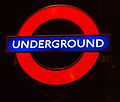
Underground logo in London
A subway or metro (short for underground railway, underground rapid transit or metropolitan) is a usually underground, rail-bound means of transport for urban public transport (ÖPNV, Stadtverkehr).
The term is used for the overall system, a subway line and route, and colloquially also for the individual vehicle (subway railcar, subway train). While the "U" is actually an abbreviation for underground, in many subway networks there are also sections on the surface, in cuttings, on railway embankments or elevated as elevated tracks. For this reason, the "U" is sometimes interpreted as "independent" in the German-speaking world - after all, these are rail transport systems that are designed to be autonomous, free of crossings and independent of other urban transport systems.
Designations
The internationally most used term outside of German usage is Metro. This is probably based on the terms Metropolitan Railway in London (today Metropolitan Line) and Chemin de fer métropolitain, or Métro, in Paris. This name has also become common in Spain and Italy. Russian, Polish and Hungarian also use the short form of this expression. Underground or Tube (London) are also common, in Scandinavia also T-Bana (Tunnelbana) or T-bane (Oslo T-bane). The subways in Manila, Singapore and Taipei are called MRT (Mass Rapid Transit), while in Hong Kong the abbreviation MTR is used for Mass Transit Railway. In North America, the term subway is in common use; rapid transit is also used for some largely above-ground systems. A few individual networks in North America are also called metro or metrorail, such as in Washington, D.C. , Los Angeles and Miami, or in French-speaking Montreal. Abbreviations such as "BART" (San Francisco and environs) or "MARTA" (Atlanta) are also in common use. Finally, in Buenos Aires, the subway is called Subte (from Subterráneo). However, "metro" is not always a generic term, but is protected as a trademark for the metro operators, especially in Spain and France.
· 
Métro logo in Paris
· 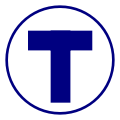
T-bana logo in Stockholm
· 
Mетро logo in Moscow
· 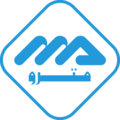
Métro logo in Algiers
· 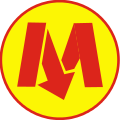
Metro logo in Warsaw
Definition and delimitation
The International Association of Public Transport (UITP) defines a metro thus: "Metro railways are an urban, electrically operated passenger transport system, flexibly integrated into a respective local transport network, providing its service at a high frequency and capacity and moving independently of any other traffic and road users on dedicated tunnel, ground level or bridge routes". This contrasts with trams, whose main characteristics, according to UITP publications, are being guided (mostly by tracks) and very high adaptability.
However, according to German (§ 4 para. 2 of the Passenger Transport Act) and Austrian (Tramway Ordinance - StrabVO) law, underground railways are tramways if they are used predominantly for passenger transport in local traffic and are not mountain railways or cableways. The umbrella term tramway is defined as railways of a special design that are adapted to the specific nature of road traffic and have a special railway body. An underground railway is thus considered a tramway in the legal sense, even though, unlike the latter, it not only has a special, but even de facto a railway body that is completely independent of road traffic. It is operated in accordance with the Ordinance on the Construction and Operation of Tramways (BOStrab).
The Association of German Transport Companies (VDV) defines a metro as a rail-bound and, based on the UITP, as a means of mass transport that is completely separate from private transport and forms a closed system. Its routes can be run in tunnels as well as on embankments and viaducts or in open terrain. In this case, independent also means that a subway usually has no level crossings with other means of rail transport and no level crossings. The traction current for underground trains is supplied via conductor rails arranged on the side of the track or via overhead lines.
Subway networks according to the VDV definition exist in Germany in the cities of Berlin, Hamburg, Munich and Nuremberg, in Austria in Vienna and in Switzerland in Lausanne. None of these underground networks runs exclusively underground.
Frankfurt am Main has a light rail system that is officially called the U-Bahn. However, since the independence of the route network is only given by the fact that all street crossings are signposted with St. Andrew's crosses and formally represent level crossings, whereby there are only gated level crossings in a few places, the designation as a subway is incorrect in this case. The same is true for the city/subway systems of Hanover, Cologne, Bonn, Stuttgart, and in the Ruhr area. The cities of Bochum and Herne in the Ruhr area have a subway line, the U35, that is almost completely separated from individual traffic, as it runs completely line-free and, with the exception of the above-ground section along Universitätsstraße through Querenburg, continuously in a completely crossing-free tunnel through Bochum and Herne. The above-ground section in Querenburg runs entirely on its own railway track and has only three level crossings with road traffic, which are not signposted as level crossings for road traffic. The traffic lights are protected by traffic signals and are equipped with an effective priority circuit, which normally prevents traffic from stopping in front of these crossings.
At the same time, the VDV distinguishes the metro conceptually from the tramway and the light rail, which can at least in part have a route on public roads, in whose area the Road Traffic Regulations must be observed. In Germany, the demarcation from the suburban railway results primarily from its legal status as a mainline railway or railway, which can also have level crossings with other means of transport, for example. In other countries, the boundaries between metros and railways are often fluid and are not legally differentiated. The distinction here is based more on the operational unity or the ownership function, as metros - unlike railways - are usually owned by municipalities.
In summary, a metro has at least the following characteristics: it is operated without level crossing with other means of transport, runs in dense timetable sequences in urban areas and is electrically operated and controlled.
There are also subway-like systems for freight transport only, such were the subways for mail transport in some cities. Pit railways and casemate railways have some similarities with underground railways, but unlike the latter, they are not primarily used for passenger transport.
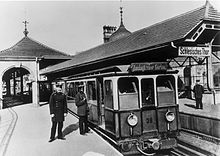
Germany's first subway: AI train with lateral power supply in Berlin's Schlesisches Tor station, 1902
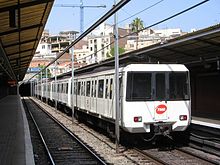
Santa Eulàlia station of the Barcelona metro, the overhead line is also designed as an overhead conductor rail outdoors

Example of a metro with overhead contact line instead of side conductor rail: M2 train of the Milan metro system
Questions and Answers
Q: What is rapid transit?
A: Rapid transit is a type of railway that has trains that run very often and carry many passengers at one time in urban areas.
Q: What is the benefit of rapid transit systems?
A: Rapid transit systems allow trains to go between places very quickly because they do not mix with other traffic.
Q: How are most rapid transit railways built?
A: Most rapid transit railways do not have level crossings, but the tracks go over and under other roads, or run in tunnels or over bridges.
Q: What are other names for rapid transit systems?
A: Other names for rapid transit systems include metro, subway, underground, tube, elevated, or heavy rail.
Q: How are rapid transit systems built?
A: Rapid transit systems vary in design in different parts of the world, with some being completely below or above ground, while others may have both below-ground and above-ground sections.
Q: What do rapid transit systems offer passengers?
A: Rapid transit systems often have many lines that go different places and many stations where people can get on and off trains, and sometimes change between other forms of public transport.
Q: What is an interchange station?
A: An interchange station is a type of station in rapid transit systems where people can change from one line to another to go in a different direction, and many of the biggest rapid transit systems have several of these stations.
Search within the encyclopedia